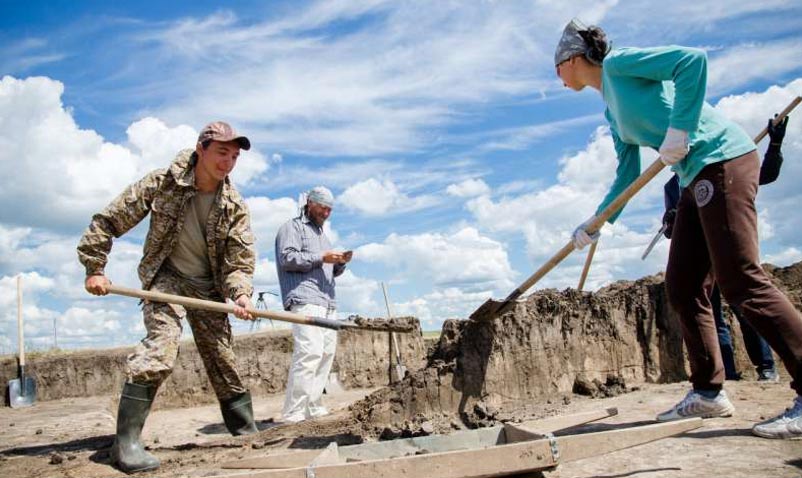4000-Year-Old Ural Necropolis Reveals Migrant Horse Breeders Died Very, Very Young
For several decades scientists of South Ural State University (SUSU), together with international colleagues from the USA and Germany, have been researching a necropolis located 280 km (173.9 miles) away from Chelyabinsk. They have unearthed more than a handful of mysteries at the Ural necropolis, but none more perplexing than a grave of people who had all died much before their time.
Life in the Fast Line
A summary of the results of this joint international research project at the Ural necropolis (Kamenny Ambar-5), were published in an article titled "Life in the fast lane: Settled pastoralism in the Central Eurasian Steppe during the Middle Bronze Age", published in the American Journal of Human Biology.
Andrey Epimakhov, professor of the Department of Russian and Foreign History, has been supervising a team of research fellows and students of SUSU's Institute of Social Sciences and Humanities as they have been excavating at Kamenny Ambar, a 4000-year-old Bronze Age settlement located in the Kartalinsky District, on the left bank of the Karagayly-Ayat River in the South of the Chelyabinsk region.
- The Bronze Age Srubna Culture and their Unique Timber Graves for the Dead
- The Thunder Stone and the Bronze Horseman: The Monolithic Savior of St Petersburg?
- City of the Dead: The Mysterious Village of Dargavs, Russia
Epimakhov told reporters at PHYS.org:
Modern archaeology is a very dynamic discipline. Today, interdisciplinary research plays a big role. For example, aside from researching environment and living conditions of ancient people, we also research their social relations. Our goal is to extend the existing knowledge and discover new aspects of life of the ancient population. First of all, we study people and try to reconstitute the history of their lives; in this aspect, our job is similar to the work of ethnographers.

Professor Andrey Epimakhov. (South Ural State University)
With this clear mission statement the international team of scientists, comprising of researchers from South Ural State University and the University of Pittsburgh investigated the “Kamenny Ambar-5 burial ground.”
No One Over 50
Seeking to determine the ages and races of the bodies, and if they suffered from diseases or injuries, physical anthropologists analyzed the entire site and made some curious observations, like nobody was older than 50, “and about 70 percent of the buried are children of various ages.” Of course everyone in the research team immediately suspected that the people must have had all suffered from a common disease, but the scientists tested the remnants for “the presence of any diseases,” and not a trace was found of any illnesses or epidemics.
What’s more, when the archaeologists discovered the bodies they had all “been buried with the full cycle of rituals, including funerary equipment and sacrifice of livestock, sheep. Adults were mainly buried with cows, horses and dogs.”

Researching of a necropolis Kamenny Ambar-5. (South Ural State University)
Attempting to put some shape around this mystery, the researchers collected DNA and mapped the genomes. Geneticists verified the archaeologists' theory that “girls were buried with ornaments, and boys with labor tools." According to the research paper, “socialization and separate formation of gender stereotypes was beginning at the age of two or three, for the Kamenny Ambar residents.”
Ural Migrant Horse Breeders
According to one idea, the bodies belong to migrants who came to the territory of the contemporary Southern Urals. Scientists are attempting to determine if this origin theory is accurate; "Reconstructions of skulls was carried out, and now we can visually demonstrate the look of the population. The remnants were found in the Kamenny Ambar burial ground. They were southern representatives of European ethnicity with a well-shaped facial skeleton and protruding nose.”
- The Spectacular Ancient Megaliths of the Ural Mountains
- Arkaim: Aryans, Advanced Astronomy and Untold Secrets of a Russian Citadel
- Butchered Dogs Consumed by Bronze Age Wolf Warriors in Rites Ceremonies
Professor Epimakhov added, "Compared to the local inhabitants, they were more subtle. This also proves that they were migrants: their ancestors were representatives of European ethnicity as well, but of different type.”

"Cossack wedding." Painting by Józef Brandt. (Public Domain)
Archaeologists first suspected that the people were livestock breeders and agriculturists but plant analysis showed “the absence of cultivated crops” and that the people were “picking wild plants and partly practiced fishing and hunting. But these activities were supplementary; their lives were founded on breeding cows, sheep and horses.” Team leader Andrey Epimakhov said, “it is with a high degree of certainty, we can say that they were sedentary livestock breeders.” ![]()
But why nobody lived over 50 remains a mystery, which surely, must be environmental?
Top Image: SUSU students researching a necropolis Kamenny Ambar-5. Source: South Ural State University
By Ashley Cowie



















